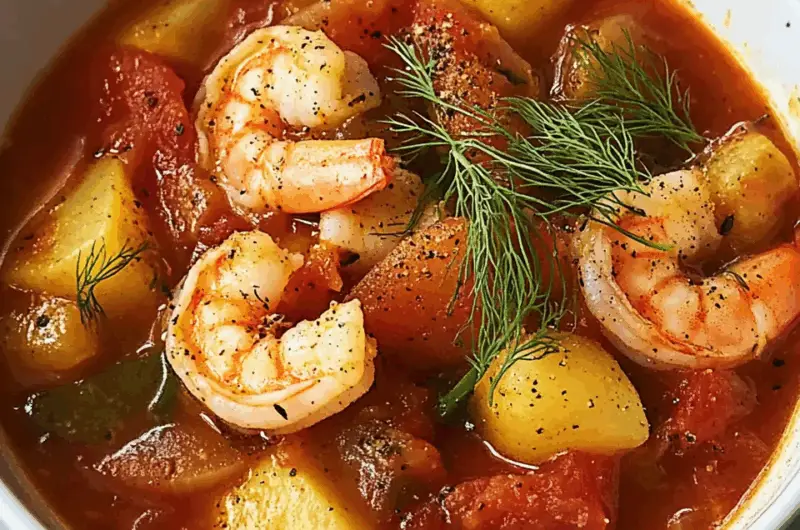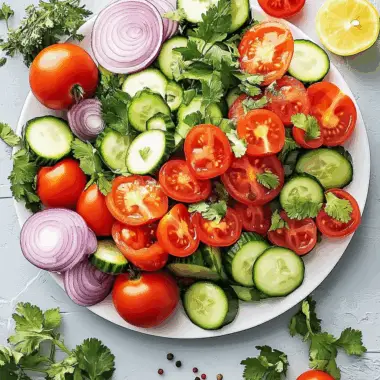This hearty shrimp stew combines tender shrimp with smoky andouille sausage and a medley of vegetables simmered in a spicy, flavorful broth. The vibrant colors of red bell pepper, fresh herbs, and the rich broth create a visually inviting and comforting dish.
Perfect for cooler evenings or whenever you want a satisfying and robust seafood meal, this stew is easy to make yet delivers complex layers of Cajun-inspired flavors. Serve it over fluffy white rice to soak up every drop of the delicious sauce, making it a true soul-warming dinner.
Full Recipe:
-
1 pound large shrimp, peeled and deveined
-
1/2 pound andouille sausage, sliced
-
1 tablespoon olive oil
-
1 medium onion, chopped
-
1 bell pepper, chopped
-
2 celery stalks, chopped
-
3 cloves garlic, minced
-
1 can (14.5 oz) diced tomatoes
-
4 cups chicken broth
-
1 teaspoon smoked paprika
-
1/2 teaspoon cayenne pepper
-
1/2 teaspoon dried thyme
-
1/2 teaspoon dried oregano
-
Salt and pepper to taste
-
2 tablespoons fresh parsley, chopped
-
Cooked white rice, for serving
Directions:
-
Heat olive oil in a large pot over medium heat. Add the sliced andouille sausage and cook until browned, about 5 minutes. Remove sausage and set aside.
-
In the same pot, add onion, bell pepper, and celery. Cook until softened, about 5 minutes.
-
Add garlic and cook for 1 minute until fragrant.
-
Stir in diced tomatoes, chicken broth, smoked paprika, cayenne pepper, thyme, oregano, salt, and pepper. Bring to a simmer.
-
Return the sausage to the pot and simmer uncovered for 15 minutes to blend flavors.
-
Add shrimp and cook until they turn pink and are cooked through, about 3-4 minutes.
-
Stir in fresh parsley. Serve hot over cooked white rice.
Prep Time: 15 minutes | Cooking Time: 30 minutes | Total Time: 45 minutes
Kcal: 350 kcal | Servings: 4 servings
The Origin and Cultural Significance of Shrimp Stew
Shrimp stew is a dish that beautifully reflects the rich culinary traditions of the American South, particularly the Gulf Coast region where seafood is abundant and deeply ingrained in local culture. Rooted in Cajun and Creole cooking, shrimp stew often features a robust blend of spices, fresh vegetables, and proteins like shrimp and sausage, making it a flavorful and hearty meal that embodies the spirit of southern hospitality. The use of andouille sausage adds a smoky depth that complements the delicate sweetness of shrimp, creating a balance of flavors that is both comforting and exciting.
Historically, this stew evolved as a way to bring together accessible ingredients from land and sea into one satisfying dish. Cajun and Creole cuisines, influenced by French, African, Spanish, and Native American cultures, emphasize bold flavors and communal dining, which shrimp stew perfectly exemplifies. Today, it remains a popular choice not just in Louisiana but throughout the United States, celebrated for its warming qualities and versatility.
Flavor Profile and Ingredients Interaction
The success of shrimp stew lies in the harmony between its key ingredients. The shrimp brings a tender, slightly sweet seafood flavor that is both light and refreshing. The andouille sausage, often smoked and spicy, introduces a robust, savory contrast. Vegetables such as bell peppers, celery, and onions—sometimes referred to as the “holy trinity” of Cajun cooking—provide a fresh, aromatic foundation that supports the heartier components of the dish.
Spices like smoked paprika, cayenne pepper, thyme, and oregano contribute layers of warmth and complexity without overpowering the natural flavors of the seafood and sausage. The use of chicken broth as a base makes the stew rich and smooth, allowing all elements to meld into a unified, delicious whole. Fresh parsley at the end adds a touch of brightness, rounding out the stew with a hint of herbaceous freshness.
Cooking Techniques and Tips for Perfection
To achieve the best results with shrimp stew, attention to cooking techniques is essential. Browning the sausage first allows it to release flavorful fats and develop a caramelized crust, which enhances the overall depth of the stew. Sautéing the vegetables next ensures they soften just enough to release their aromas without becoming mushy, which keeps the texture balanced.
Simmering the stew uncovered for a period helps concentrate the flavors, allowing the broth to thicken slightly and the spices to infuse every bite. It is important to add the shrimp towards the end of cooking because shrimp cooks quickly and can become rubbery if overcooked. The shrimp should be just opaque and tender when the stew is done.
When serving, a bed of fluffy white rice is traditional, as it soaks up the flavorful broth and makes the dish more filling. For a twist, some may prefer crusty bread or even grits on the side to complement the rich stew.
Variations and Customizations
One of the great joys of shrimp stew is its adaptability. While the classic version relies on andouille sausage and a set blend of spices, there are many ways to tailor the dish to suit your taste or dietary needs. For example, swapping andouille for chorizo or another smoked sausage can bring different flavor profiles. For a milder stew, reduce or omit the cayenne pepper.
Vegetables can be varied, adding diced tomatoes or even okra for a more traditional gumbo-style stew. For those who prefer a lighter dish, shrimp stew can be made without sausage or with turkey sausage as a leaner alternative.
Vegetarian versions are also possible by substituting the shrimp and sausage with hearty vegetables like mushrooms, eggplant, and beans, while using vegetable broth. Spices and herbs can be adjusted to keep the boldness intact.
Nutritional Benefits and Considerations
Shrimp stew offers a balanced combination of protein, vegetables, and moderate carbohydrates when served with rice. Shrimp itself is a lean protein source, rich in vitamins such as B12 and minerals like selenium and iodine. The vegetables add dietary fiber and antioxidants, supporting digestion and immune health.
The sausage, while flavorful and adding richness, is higher in fat and sodium, so it can be moderated or substituted to fit dietary preferences. Using fresh, high-quality ingredients and limiting added salt keeps this stew a wholesome and satisfying meal option.
Serving Occasions and Pairings
Shrimp stew is incredibly versatile and can be served on casual weeknights or at festive gatherings. It pairs wonderfully with crisp green salads, roasted vegetables, or simple coleslaw to balance its richness. For drinks, a chilled white wine like Sauvignon Blanc or a cold beer can complement the stew’s spicy and smoky flavors.
Because it’s a warming, filling dish, shrimp stew is especially popular during cooler months but is equally enjoyed year-round thanks to its fresh seafood base. It’s perfect for sharing with family and friends, reflecting the communal dining traditions of Cajun culture.
The Comfort and Connection in a Bowl
At its heart, shrimp stew is more than just a meal—it’s a comfort food that brings people together. The layers of flavor, the blend of fresh seafood and smoky sausage, and the aroma filling the kitchen evoke memories and feelings of warmth and hospitality. Whether you’re revisiting a beloved Southern tradition or trying it for the first time, this stew invites you to slow down, savor each bite, and appreciate the rich cultural heritage behind every spoonful.
Conclusion
Shrimp stew is a vibrant, flavorful dish that captures the essence of Cajun and Creole cooking with its bold spices, fresh ingredients, and satisfying textures. It is a perfect example of how simple components can be transformed into a complex and comforting meal that appeals to a wide range of palates. Its flexibility allows home cooks to customize the recipe to their liking, making it a timeless favorite in many households.
Whether you’re seeking a quick weeknight dinner or a show-stopping dish for guests, shrimp stew delivers warmth, nutrition, and rich cultural roots in every bowl. Embracing this recipe on your menu means inviting a taste of Southern tradition and the joyful experience of communal eating into your home.








